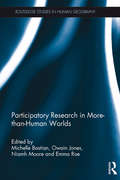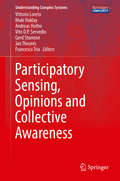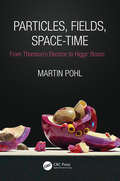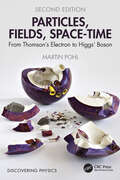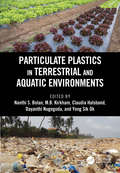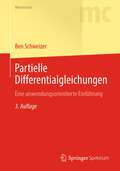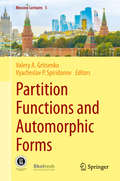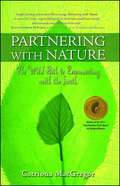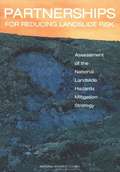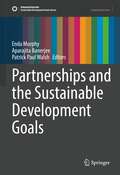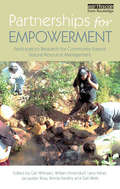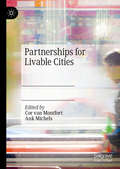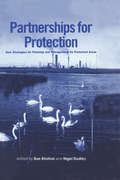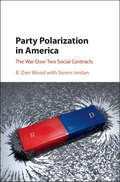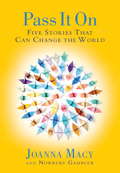- Table View
- List View
Participatory Research in More-than-Human Worlds (Routledge Studies in Human Geography)
by Owain Jones Emma Roe Niamh Moore Michelle BastianSocio-environmental crises are currently transforming the conditions for life on this planet, from climate change, to resource depletion, biodiversity loss and long-term pollutants. The vast scale of these changes, affecting land, sea and air have prompted calls for the ‘ecologicalisation’ of knowledge. This book adopts a much needed ‘more-than-human’ framework to grasp these complexities and challenges. It contains multidisciplinary insights and diverse methodological approaches to question how to revise, reshape and invent methods in order to work with non-humans in participatory ways. The book offers a framework for thinking critically about the promises and potentialities of participation from within a more-than-human paradigm, and opens up trajectories for its future development. It will be of interest to those working in the environmental humanities, animal studies, science and technology studies, ecology, and anthropology.
Participatory Sensing, Opinions and Collective Awareness
by Andreas Hotho Gerd Stumme Vittorio Loreto Muki Haklay Vito D. P. Servedio Jan Theunis Francesca TriaThis book introduces and reviews recent advances inthe field in a comprehensive and non-technical way by focusing on the potentialof emerging citizen-science and social-computation frameworks, coupled with thelatest theoretical and modeling tools developed by physicists, mathematicians,computer and social scientists to analyse, interpret and visualize complex datasets. There is overwhelming evidence that the currentorganisation of our economies and societies is seriously damaging biologicalecosystems and human living conditions in the short term, with potentiallycatastrophic effects in the long term. The need to re-organise the dailyactivities with the greatest impact - energy consumption, transport, housing -towards a more efficient and sustainable development model has recently beenraised in the public debate on several global, environmental issues. Above all,this requires the mismatch between global, societal and individual needs to beaddressed. Recent advances in Information and Communication Technologies (ICT)can trigger important transitions at the individual and collective level toachieve this aim. Based on the findings of the collaborative researchnetwork EveryAware the following developments among the emerging ICTtechnologies are discussed in depth in this volume: * Participatory sensing - where ICT development ispushed to the level where it can supportinformed action at the hyperlocal scale, providing capabilities forenvironmental monitoring, data aggregation and mining, as well as informationpresentation and sharing. * Web gaming, social computing and internet-mediatedcollaboration - where the Web will continue to acquire the status of aninfrastructure for social computing, allowing users' cognitive abilities to becoordinated in online communities, and steering the collective action towardspredefined goals. * Collective awareness and decision-making - where theaccess to both personal and community data, collected by users, processed withsuitable analysis tools, and re-presented in an appropriate format by usablecommunication interfaces leads to a bottom-up development of collective socialstrategies.
Particles and Fundamental Interactions
by Sylvie Braibant Maurizio Spurio Giorgio GiacomelliThe book provides theoretical and phenomenological insights on the structure of matter, presenting concepts and features of elementary particle physics and fundamental aspects of nuclear physics. Starting with the basics (nomenclature, classification, acceleration techniques, detection of elementary particles), the properties of fundamental interactions (electromagnetic, weak and strong) are introduced with a mathematical formalism suited to undergraduate students. Some experimental results (the discovery of neutral currents and of the W± and Z0 bosons; the quark structure observed using deep inelastic scattering experiments) show the necessity of an evolution of the formalism. This motivates a more detailed description of the weak and strong interactions, of the Standard Model of the microcosm with its experimental tests, and of the Higgs mechanism. The open problems in the Standard Model of the microcosm and macrocosm are presented at the end of the book. For example, the CP violation currently measured does not explain the matter-antimatter asymmetry of the observable universe; the neutrino oscillations and the estimated amount of cosmological dark matter seem to require new physics beyond the Standard Model. A list of other introductory texts, work reviews and some specialized publications is reported in the bibliography. Translation from the Italian Language Edition "Particelle e interazioni fondamentali" by Sylvie Braibant, Giorgio Giacomelli, and Maurizio Spurio Copyright © Springer-Verlag Italia, 2009 Springer-Verlag Italia is part of Springer Science+Business Media All Rights Reserved
Particles and Fundamental Interactions: Supplements, Problems and Solutions
by Sylvie Braibant Maurizio Spurio Giorgio GiacomelliThis volume is an exercises and solutions manual that complements the book "Particles and Fundamental Interactions" by Sylvie Braibant, Giorgio Giacomelli, and Maurizio Spurio. It aims to give additional intellectual stimulation for students in experimental particle physics. It will be a helpful companion in the preparation of a written examination, but also it provides a means to gaining a deeper understanding of high energy physics. The problems proposed are sometimes true and important research questions, which are described and solved in a step-by-step manner. In addition to the problems and solutions, this book offers fifteen Supplements that give further insight into topical subjects related to particle accelerators, signal and data acquisition systems and computational methods to treat them.
Particles in the Coastal Ocean Theory and Applications
by Jr. Daniel R. Lynch David A. Greenberg Ata Bilgili Dennis J. Mcgillicuddy James P. Manning Alfredo L. AretxabaletaThe coastal ocean comprises the semi-enclosed seas on the continental shelf, including estuaries and extending to the shelf break. This region is the focus of many serious concerns, including coastal inundation by tides, storm surges, or sea level change; fisheries and aquaculture management; water quality; harmful algal blooms; planning of facilities (e. g. , power stations); port development and maintenance; and oil spills. This book addresses modeling and simulation of the transport, evolution, and fate of particles (physical and biological) in the coastal ocean. It is the first to summarize the state of the art in this field and direct it toward diverse applications, for example in measuring and monitoring sediment motion, oil spills, and larval ecology. This is an invaluable textbook and reference work for advanced students and researchers in oceanography, geophysical fluid dynamics, marine and civil engineering, computational science, and environmental science.
Particles in the Dark Universe: A Student’s Guide to Particle Physics and Cosmology
by Yann MambriniThis book provides a comprehensive and instructive coverage of particle physics in the early universe, in a logical way. It starts from the thermal history of the universe by investigating some of the main arguments such as Big Bang nucleosynthesis, the cosmic microwave background (CMB) and the inflation, before treating in details the direct and indirect detection of dark matter and then some aspects of the physics of neutrino. Following, it describes possible candidates for dark matter and its interactions.The book is targeted at theoretical physicists who deal with particle physics in the universe, dark matter detection and astrophysical constraints, and at particle physicists who are interested in models of inflation or reheating. This book offers also material for astrophysicists who work with quantum field theory computations. All that is useful to compute any physical process is included: mathematical tables, all the needed functions for the thermodynamics of early universe and Feynman rules. In light of this, this book acts as a crossroad between astrophysics, particle physics and cosmology.
Particles in the Dark Universe: A Student’s Guide to Particle Physics and Cosmology
by Yann MambriniThis second edition of Particles in the Dark Universe has been substantially enhanced with several new chapters that delve into crucial aspects of particle physics in the Universe. These additions encompass the role of primordial black holes in the early universe, tracing their formation to decay, unification theories, a comprehensive historical overview of cosmological models, an extensive examination of the physics of the graviton, and an educational exploration of gravitational phenomena such as Unruh-type or Hawking radiation. Additionally, this edition incorporates 30 new exercises and provides a comprehensive presentation of inflationary models, along with a pedagogical insight into the mechanism of baryogenesis. Structured in a logical sequence, this book offers a thorough and instructional exploration of particle physics within the early universe. It initiates by elucidating the thermal history of the universe, delving into pivotal concepts like Big Bang nucleosynthesis, the cosmic microwave background (CMB), and inflation. Subsequently, it meticulously addresses both direct and indirect detection methods of dark matter, followed by an in-depth analysis of neutrino physics. The book further scrutinizes potential candidates for dark matter and their interactions. Designed for theoretical physicists engaged in particle physics within the universe, dark matter detection, astrophysical constraints, and those interested in models of inflation or reheating, this book also caters to astrophysicists involved in quantum field theory computations. It encompasses all essential elements required for computing various physical processes, providing mathematical tables, necessary thermodynamic functions for the early universe, and Feynman rules. Consequently, this book serves as an intersecting point between astrophysics, particle physics, and cosmology.
Particles, Fields, Space-Time: From Thomson’s Electron to Higgs’ Boson
by Martin PohlCHOICE Highly Recommended 2021Particles, Fields, Space-Time: From Thomson's Electron to Higgs' Boson explores the concepts, ideas, and experimental results that brought us from the discovery of the first elementary particle in the end of the 19th century to the completion of the Standard Model of particle physics in the early 21st century. The book concentrates on disruptive events and unexpected results that fundamentally changed our view of particles and how they move through space-time. It separates the mathematical and technical details from the narrative into focus boxes, so that it remains accessible to non-scientists, yet interesting for those with a scientific background who wish to further their understanding. The text presents and explains experiments and their results wherever appropriate.This book will be of interest to a general audience, but also to students studying particle physics, physics teachers at all levels, and scientists with a recreational curiosity towards the subject.Features Short, comprehensive overview concentrating on major breakthroughs, disruptive ideas, and unexpected results Accessible to all interested in subatomic physics with little prior knowledge required Contains the latest developments in this exciting field
Particles, Fields, Space-Time: From Thomson’s Electron to Higgs’ Boson (Discovering Physics)
by Martin PohlParticles, Fields, Space-Time: From Thomson’s Electron to Higgs’ Boson explores the concepts, ideas, and experimental results that brought us from the discovery of the first elementary particle in the end of the 19th century to the completion of the Standard Model of particle physics in the early 21st century. The book concentrates on disruptive events and unexpected results that fundamentally changed our view of particles and how they move through space-time. It separates the mathematical and technical details from the narrative into focus boxes, so that it remains accessible to non-scientists, yet interesting for those with a scientific background who wish to further their understanding. The text presents and explains experiments and their results wherever appropriate. This book is of interest to a general audience but also to students studying particle physics, physics teachers at all levels, and scientists with a recreational curiosity towards the subject. For this second edition, the complete text has been thoroughly revised. A description of plans for new accelerator facilities has been added, as well as new results on cosmic ray physics, dark matter and dark energy. The usage of natural units has been abandoned in favour of SI units throughout the text.Key Features: Short, comprehensive overview concentrating on major breakthroughs, disruptive ideas, and unexpected results Accessible to all interested in subatomic physics with little prior knowledge required Contains the latest developments in this exciting field
Particulate Plastics in Terrestrial and Aquatic Environments
by Nanthi S. Bolan, M.B. Kirkham, Claudia Halsband, Dayanthi Nugegoda, Yong Sik OkThe manufacture of plastic as well as its indiscriminate disposal and destruction by incineration pollutes atmospheric, terrestrial, and aquatic ecosystems. Synthetic plastics do not break down; they accumulate in the environment as macro-, micro-, and nanoplastics. These particulate plastics are a major source of pollutants in soil and marine ecosystems. Particulate Plastics in Terrestrial and Aquatic Environments provides a fundamental understanding of the sources of these plastics and the threats they pose to the environment. The book demonstrates the ecotoxicity of particulate plastics using case studies and offers management practices to mitigate particulate plastic contamination in the environment. Features · Describes physical and chemical properties of particulate plastics in terrestrial and aquatic ecosystems · Presents information on characteristics of particulate plastics as impacted by weathering processes · Provides numerous approaches for managing particulate plastic contamination · Identifies sources of particulate plastics in the environment; distribution and characteristics of particulate plastics; and management strategies of particulate plastics Written by a global team of scientists, this book is for researchers in the fields of environmental safety and waste management or individuals interested in the impact of particulate plastics on environmental health.
Partielle Differentialgleichungen: Eine anwendungsorientierte Einführung (Masterclass)
by Ben SchweizerDas Buch führt in die Theorie der Partiellen Differentialgleichungen ein, lediglich die Grundvorlesungen der Analysis werden vorausgesetzt. Eine Vielzahl linearer und nichtlinearer Differentialgleichungen wird mit Modellierungsansätzen motiviert und rigoros analysiert. Nach den klassischen linearen Problemen der Potentialtheorie und Wärmeleitung werden insbesondere nichtlineare Probleme aus der Theorie poröser Medien, der Strömungsmechanik und der Festkörpermechanik behandelt. Entlang der Aufgabenstellungen von zunehmender Komplexität werden moderne Methoden und Theorien der Analysis entwickelt.Für die vorliegende 3. Auflage wurde der Text überarbeitet und korrigiert, an vielen Stellen wurden Beweisabläufe optimiert und Motivationstexte eingebaut. An anderen Stellen inhaltlich ausgedünnt und verkürzt, um den Vorlesungsumfang nicht zu sprengen.
Partition Functions and Automorphic Forms (Moscow Lectures #5)
by Valery A. Gritsenko Vyacheslav P. SpiridonovThis book offers an introduction to the research in several recently discovered and actively developing mathematical and mathematical physics areas. It focuses on: 1) Feynman integrals and modular functions, 2) hyperbolic and Lorentzian Kac-Moody algebras, related automorphic forms and applications to quantum gravity, 3) superconformal indices and elliptic hypergeometric integrals, related instanton partition functions, 4) moonshine, its arithmetic aspects, Jacobi forms, elliptic genus, and string theory, and 5) theory and applications of the elliptic Painleve equation, and aspects of Painleve equations in quantum field theories. All the topics covered are related to various partition functions emerging in different supersymmetric and ordinary quantum field theories in curved space-times of different (d=2,3,…,6) dimensions. Presenting multidisciplinary methods (localization, Borcherds products, theory of special functions, Cremona maps, etc) for treating a range of partition functions, the book is intended for graduate students and young postdocs interested in the interaction between quantum field theory and mathematics related to automorphic forms, representation theory, number theory and geometry, and mirror symmetry.
Partnering with Nature: The Wild Path to Reconnecting with the Earth
by Catriona MacgregorPartnering with Nature is a simple book with a powerful message: our connections to the natural environment-- and ultimately, to ourselves--are crucial in today's fragmented world. As each successive generation moves farther away from nature, the growing disconnect is expressed through physical as well as mental stress, from depression and fatigue in adults to attention disorders and obesity in children. The way we relate to nature helps define our place within it, and by awakening this natural, yet dormant connection to the environment around us, we can move beyond solitary stewardship and into partnership.In Partnering with Nature, Catriona MacGregor weaves together scientific and historical wisdom, spiritual insights, and inspiring stories that illuminate the energies that link humans, animals, and the natural world. Through observation and conscious practice, we can open up to the power of nature to transform our lives, uplift our spirits, and even to direct our bodies to a healthier potential. For everyone who has a sense of something missing, who wishes to make a difference in their world, who yearns to reclaim their sense of wonder and awe, or who struggles with their health or emotional balance--nature speaks to all who will listen.
Partnerships For Reducing Landslide Risk: Assessment of the National Landslide Hazards Mitigation Strategy
by Committee on the Review of the National Landslide Hazards Mitigation StrategyLandslides occur in all geographic regions of the nation in response to a wide range of conditions and triggering processes that include storms, earthquakes, and human activities. Landslides in the United States result in an estimated average of 25 to 50 deaths annually and cost $1 to 3 billion per year. In addition to direct losses, landslides also cause significant environmental damage and societal disruption. This report reviews the U.S. Geological Survey’s (USGS) National Landslide Hazards Mitigation Strategy, which was created in response to a congressional directive for a national approach to reducing losses from landslides. Components of the strategy include basic research activities, improved public policy measures, and enhanced mitigation of landslides.The NRC report commends the USGS for creating a national approach based on partnerships with federal, state, local, and non-governmental entities, and finds that the plan components are the essential elements of a national strategy. The report recommends that the plan should promote the use of risk analysis techniques, and should play a vital role in evaluating methods, setting standards, and advancing procedures and guidelines for landslide hazard maps and assessments. The NRC panel suggests that substantially increased funding will be required to implement a national landslide mitigation program, and that as part of a 10-year program the funding mix should transition from research and guideline development to partnership-based implementation of loss reduction measures.
Partnerships and the Sustainable Development Goals (Sustainable Development Goals Series)
by Enda Murphy Aparajita Banerjee Patrick Paul WalshThis volume fills a significant gap in the scientific and policy literature on the Sustainable Development Goals (SDGs) and on SDG 17 which focuses on partnership as a means of implementation (MOI) for the SDGs. The collection offers a strong theoretical context, and outlines the nature of partnerships (e.g. alternative forms, multi-level forms, barriers to take-up) using the most recent UN database as well as through key case studies that highlight partnership successes and failures at local, national and global scales. The text covers a brief history and background of partnerships and the SDGs, an analysis of existing SDG partnership using UN data, a scalar analysis of case studies involving multi-stakeholder partnerships, and recommendations for successful partnership models and implementation strategies. The book will be relevant for a wide variety of readerships including academics in different policy fields and disciplines, policymakers, SDG advocates and practitioners, and NGOs active in the promotion of the SDGs and environmental issues. Provides a unique outline of partnership theory and its application to the SDGs Outlines the nature of partnerships, including their multi-level forms and barriers to take-up using UN data Analyzes key SDG partnerships case studies that highlight partnership success stories for practitioners
Partnerships for Empowerment: Participatory Research for Community-based Natural Resource Management
by Carl Wilmsen Larry Fisher Jacquelyn Ross Brinda Sarathy Gail Wells William ElmendorfParticipatory research has emerged as an approach to producing knowledge that is sufficiently grounded in local needs and realities to support community-based natural resource management (CBNRM), and it is often touted as crucial to the sustainable management of forests and other natural resources. This book analyses the current state of the art of participatory research in CBNRM. Its chapters and case studies examine recent experiences in collaborative forest management, harvesting impacts on forest shrubs, watershed restoration in Native American communities, civic environmentalism in an urban neighborhood and other topics. Although the main geographic focus of the book is the United States, the issues raised are synthesized and discussed in the context of recent critiques of participatory research and CBNRM worldwide. The book's purpose is to provide insights and lessons for academics and practitioners involved in CBNRM in many contexts. The issues it covers will be relevant to participatory research and CBNRM practitioners and students the world over.
Partnerships for Livable Cities
by Cor Van Montfort Ank MichelsIn this volume scholars from around the world discuss the innovative forms of collaboration between public and private actors that contribute to making our cities more liveable. It offers helpful insights into the practices of partnerships and the ways in which partnerships can contribute to a more liveable urban environment. The liveability of our cities is a topic of increasing relevance and urgency. The world’s cities are becoming congested and polluted, putting pressure on affordable housing and causing safety to become a major problem. Urban governments are unable to address these major challenges on their own, and thus they seek cooperation with other governments, companies, civil society organizations, and citizens. By focusing on examples such as greenery in the city, affordable housing, safety, neighbourhood revitalization, and ‘learning by doing’ in urban living labs, this book asks two key questions. How do partnerships between public and private actors contribute to the liveability of cities? Under what conditions are partnerships successful, and when do they fail to yield the desired results?
Partnerships for Protection: New Strategies for Planning and Management for Protected Areas
by Gonzalo Oviedo Adrian Phillips Jean-Paul Jeanrenaud Nigel Dudley Sue Stolton Biksham Gujja Bill Jackson Pedro Rosabal Sue WellsTaking into consideration the fact that many ecosystems are under-represented in protected areas of land and water and traditional management methods have often been ineffective, this volume describes how improvements can be made. Specifically, it explores ways of ensuring that all major ecosystems are safeguarded, and innovative approaches to conservation involving individuals, communities, companies and governments. The essence of the approach taken in the text is to build partnerships with those who have a stake in the care of land and water resources.
Party Polarization in America: The War Over Two Social Contracts
by Wood Soren Jordan B. DanThis book develops a general explanation for party polarization in America from both historical and contemporary perspectives. Prior polarization studies focused exclusively on the modern era, but this work traces party polarization from the constitutional convention of 1787 to the present. Using such a broad historical perspective shows that what was unusual in American history was the period of low polarization from the Great Depression through 1980, rather than the period of high polarization of the modern era. Polarization is the norm of the American system, not the exception, and is likely to persist in the future. More theoretically, party polarization in America has been due to class-based conflict and rent-seeking by the patrician and plebian classes in various historical eras, rather than conflict over cultural values. As in earlier historical eras, modern party polarization has largely been elite-driven, with party entrepreneurs cunningly and strategically using polarization to their advantage.
Paryatan Bhugol First Semester FYBA New NEP Syllabus - SPPU: पर्यटन भूगोल प्रथम सत्र एफ.वाय.बी.ए. नवीन एन.इ.पी. अभ्यासक्रम - सावित्रीबाई फुले पुणे यूनिवर्सिटी
by Prof. Dr. Jyotiram Chandrakant More Prof. Dr. Sanjay Dagu Pagar Prof. Dr. Dilip Dnyaneshwar Muluk Prof. Nitin Bajirao Borseपर्यटन भूगोल हे पुस्तक सावित्रीबाई फुले पुणे विद्यापीठाच्या नवीन राष्ट्रीय शैक्षणिक धोरण (NEP) 2020 अंतर्गत विकसित केले गेले आहे. "पर्यटन भूगोल" या पुस्तकात पर्यटनाच्या संकल्पना, घटक, प्रकार आणि नियोजनाच्या तांत्रिक बाबींचा सखोल अभ्यास केला आहे. पुस्तकामध्ये पर्यावरणीय, सामाजिक, सांस्कृतिक व आर्थिक दृष्टिकोनातून पर्यटनाच्या विविध पैलूंचा आढावा घेतला आहे. सत्र 1 मध्ये पर्यटन भूगोलाची व्याख्या, स्वरूप, पर्यटनाचे वर्गीकरण व आधुनिक प्रकार मांडले आहेत. सत्र 2 मध्ये सहल नियोजन, आवश्यक तंत्रज्ञान, पासपोर्ट-व्हिसा प्रक्रिया, आणि राष्ट्रीय-आंतरराष्ट्रीय सहल नियोजनाचा समावेश आहे. पुस्तक विद्यार्थ्यांसह, पर्यटन व्यवसायाशी संबंधित प्राध्यापक, संशोधक व पर्यटकांसाठी अत्यंत उपयुक्त आहे.
Paryavaran Aur Hum class 7 - JCERT: पर्यावरण और हम ७वीं कक्षा - जेसीईआरटी
by Jharkhand Shaikshik Anusandhan Evam Prashikshan Parishad Ranchi"पर्यावरण और हम" पुस्तक झारखंड शैक्षिक अनुसंधान एवं प्रशिक्षण परिषद द्वारा प्रकाशित की गई है। यह सातवीं कक्षा के भूगोल विषय पर आधारित है और छात्रों में पर्यावरण के प्रति जागरूकता बढ़ाने के उद्देश्य से लिखी गई है। पुस्तक में प्राकृतिक एवं मानव निर्मित पर्यावरण की जानकारी दी गई है, जिसमें स्थलमंडल, जलमंडल, वायुमंडल, जैवमंडल आदि विषयों का विस्तार से वर्णन किया गया है। प्राकृतिक पर्यावरण में भूमि, जल, वायु, पेड़-पौधे और जीव-जंतु शामिल होते हैं, जबकि मानव निर्मित पर्यावरण में इंसानों द्वारा बनाई गई वस्तुएँ जैसे सड़क, घर, और मशीनें शामिल हैं। पुस्तक में पर्यावरण प्रदूषण के विभिन्न प्रकार जैसे वायु, जल और भूमि प्रदूषण के कारण और उनके निवारण के उपाय भी बताए गए हैं। इसमें जलवायु परिवर्तन और उसके प्रभावों पर भी चर्चा की गई है। पुस्तक का एक महत्वपूर्ण हिस्सा यह बताता है कि कैसे हम छोटे-छोटे कदमों से पर्यावरण संरक्षण में योगदान दे सकते हैं। जलवायु परिवर्तन, ग्लोबल वार्मिंग, और प्राकृतिक संसाधनों के उपयोग के प्रति संवेदनशीलता विकसित करने के उद्देश्य से यह पुस्तक विद्यार्थियों के लिए बेहद उपयोगी है। छात्रों को पर्यावरण संरक्षण के प्रति जिम्मेदार और जागरूक नागरिक बनाने के लिए इसमें शिक्षकों के सहयोग और सहभागिता को भी महत्वपूर्ण बताया गया है।
Parícutin: The Life and Death of a Volcano (Fountas & Pinnell LLI Purple #Level R)
by Laura TabbertThe ground swelled and raised itself... Fine dust, like ashes, began to rise from the crack. Smoke began to rise with a loud hiss.
Pass it On
by Joanna Macy Norbert GahblerEco-philosopher and best-selling author Joanna Macy shares five stories from her more than 30 years of studying and practicing Buddhism and deep ecology. Gathered on her travels to India, Russia, Australia, and Tibet, these stories testify to Joanna Macy's belief that either humankind awakens to a new and deeper understanding of our interconnectedness with its planet or risks loosing it. Pass it On tells of encounters with individuals who share very personal stories of sudden awakening, unexpected awareness, and the co-mingling of joy and pain. Each story is imbued with the specific cultural flavor of the places where the stories originate, but all show how each individual counts in the global need for change and awakening.
Pass it On: Five Stories That Can Change the World
by Joanna Macy Norbert GahblerEco-philosopher and best-selling author Joanna Macy, Ph.D., shares five stories from her more than thirty years of studying and practicing Buddhism and deep ecology. Gathered on her travels to India, Russia, Australia, and Tibet, these stories give testament to Joanna Macy's belief that either humankind awakens to a new and deeper understanding of our interconnectedness with our planet and all its myriad forms of life or risks loosing it. To bring about such a transformation of consciousness each and every one of us counts. Five Stories that Can Change the World tells of encounters with individuals who share very personal stories of sudden awakening, unexpected awareness, and the co-mingling of joy and pain. Each story is imbued with the specific cultural flavor of the places where the stories originate, but all share that each individual counts in the global need for change and awakening.Pas It On provides an introduction to Joanna Macy's work of "deep ecology" and "the great turning" and the deep interconnected nature of all beings.Introduction by Norbert Gahbler.
Pass the Energy, Please!
by Barbara McKinneyNature's food chains are sometimes short (grass eaten by deer) and sometimes long (goldenrod eaten by caterpillar, eaten by spider, eaten by warbler, eaten by weasel, eaten by fox). Everyone is part of nature's fascinating circle of players.
